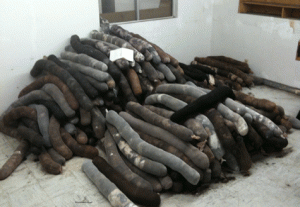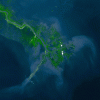As the crude continues to gush into the Gulf of Mexico from the deadly Deepwater Horizon oil well disaster, observers are barraged with snapshots of past cleanup tactics tried, tested or hopeful. So far, response to this disaster has tended more toward hope over help, as BP and U.S. Coast Guard efforts to date — using fire, dispersants, booms, absorbents and a massive dome designed to siphon the oil into a tanker sitting more than 5,000 feet above the wellhead — have not worked to any extent.
Meanwhile, 40 percent of the nation’s wetlands lay in the oil slick’s path, to say nothing of hundreds of miles of coastline in five states.
As the debacle slowly and painfully plays out, Miller-McCune.com takes a look at a few historical methods of countering oil spills — as well as some decidedly modern ideas that include the use of hairballs and raging rivers.
All this is tempered by something UC Berkeley’s Robert Bea, a seasoned expert in oil spills, told our Melinda Burns last week about cleanups: “It’s more sophisticated today, but it’s the same damned thing. Unfortunately, we have not progressed very far since the miserable experiences of Santa Barbara and the Exxon Valdez.”
Bomb the #$@! out of it
Not surprisingly, fire was one of the first containment methods tried on BP’s Deepwater Horizon. Fighting fire with fire would seem to make sense (maybe). However, history has shown its use is often ineffective because it requires calm seas — as do many other recovery techniques like booms, skimmers and containment/recovery.

There are a few instances where fire has been quite effective, including a spill when the American tanker Odyssey sank off the Nova Scotia coast in 1988; a fire on the ship and the resultant burning of the estimated 132,000 tons of crude made shore cleanup unnecessary. (We won’t talk about air cleanup.)
Of the 120 oceanic oil spills reported by the Mariner Group, the first use of fire occurred when the Torrey Canyon ran aground off Cornwall, England, in 1967, releasing 860,000 barrels of oil.
After an ineffective bout using detergents to disperse the oil, the Royal Navy and Air Force later “dropped 62,000 pounds of bombs, 5,200 gallons of petrol, 11 rockets and large quantities of napalm” on the supertanker to sink it and burn off oil. The limeys also rained 1,000-pound shells on it.
The tanker refused to sink and a particularly high spring tide snuffed out the fire. Later it was reported that a quarter of the 42 bombs dropped by the Fleet Air Arm failed to hit their mark, an achievement derided by the British populace.
With the oil slick heading to the French coast of Normandy, the Navy bombed again and succeeded in submerging the Torrey Canyon. However, as has often been the case, human attempts to contain, recover or disperse the oil were to little avail. The BBC reported the oil was “finally dispersed by favorable weather, but not before 70 miles of Cornish beaches were seriously contaminated and tens of thousands of seabirds killed.”
Recover, recover, recover
The most attractive idea is to recover the oil while it’s still in the ocean, but that’s seen scant success over the years. The French gave it a good go when the Maltese tanker Erika, loaded with heavy fuel oil, broke into two parts and sank 40 miles off the Brittany coast in 1999.

After high seas made a comedy of errors out of cleanup attempts with skimmers and booms, the recovery team — with boats provided by France, The Netherlands, Germany and the United Kingdom — was able to direct-pump oil into five recovery boats. They captured 1,100 of about 20,000 tons. A report released after the spill noted that even though the amount recovered was relatively small, collecting 1 ton of oil in the sea meant 10 to 20 tons of oiled debris does not wash ashore. Another positive, so to speak, was the post-Erika realization that single-hulled tankers were a clear and present danger, and should be phased out.
The oil-spill team seemed so intent on recovery that accounts of other cleanup activities are scanty, other than the fact that more than 100 miles of Brittany’s coastline were contaminated, some 100,000 seabirds were killed — a record at that time — and a government institute warned volunteers cleaning oil-cloaked beaches that they risked developing cancer.
Bald is beautiful
The sense of helplessness and despair that arises from an oil spill may have an outlet this time. There’s actually something people living far from the spill can do to help.

Need a haircut? Is your dog’s coat in need of a trim? Time to sheer that sheep in your back yard? Bag that hair and ship it to Matter of Trust, a San Francisco-based nonprofit that since 1998 has been turning donations of pet fur, human hair and wool waste into oil-absorbing hair mats and containment booms. The containment method for the hair in the booms is even politically correct — recycled pantyhose.

Matter of Trust announced it is receiving “hundreds of thousands of pounds of hair” packages — many of them from hair salons and dog grooming operations — from every U.S. state as well as from Canada, the United Kingdom, France, Spain, Germany and Brazil. And the nonprofit is setting up warehouses in Alabama, Mississippi, Louisiana and Florida so that volunteers can help stuff the hair into tubes and booms.
Some may belittle this low-tech solution, but that overlooks a key aspect of hair: Hair booms and mats qualify as adsorbents (as opposed to absorbents). Adsorbent materials pick up and retain liquid without swelling and have a good record in oil cleanups, at least in small applications. Their inherent nimbleness could make them a natural for protection of wetlands.
Social networking for a cause
Another potential for citizen-activism arises through an Internet software application that uses a “crowdsourcing” technology originally developed to track violence in Kenya.

The Louisiana Bucket Brigade has employed the technology, called Ushahidi (which means “testimony” in Swahili), to motivate citizens in the Gulf Coast to report fallout from the BP spill. Intrepid citizen observers can report sightings of oil sheen on the water or oil onshore, along with information in a series of categories including odor, health effects, marine wildlife and birds, and even solutions.
Reports and locations are entered on interactive maps, which themselves tell a story. A blog post on e.politics notes that the information may eventually be cross-referenced with satellite imagery and data on water quality and other measurements taken by scientists working in the Gulf. Writer Colin Delany notes the information gathering will allow more people to contribute to the policy debate because “every data point on the map will represent a real (rather than a theoretical or anticipated) effect of the spill.”
A recent visit to the site revealed 229 reports.
Use that resource
Talk about getting involved! Look at the Indians who inhabited the California coast and Channel Islands, just west of Miller-McCune’s home of Santa Barbara. The local Chumash Indians obviously weren’t drilling deep offshore wells or crewing supertankers to deliver their energy, but ongoing natural seepages of oil and natural gas — sometimes described as a “permanent natural oil spill” — had long washed goo onto area beaches. In words that could be cribbed by reporters off Louisiana right now, explorer George Vancouver, among the first Europeans in the area, wrote, “The sea had the appearance of dissolved tar floating on its surface, which covered the sea in all directions.”

The Chumash made lemonade from the lemons, and used the oil tar as a base for paint, in artwork, to waterproof their baskets and canoes and to roof their homes. Later, settlers used it to grease their wagons and farm machinery, for tarring roofs and for illumination. In oil-spill speak, this would be termed recovery.
Even oil companies got into the reuse act with these seeps. In 1992, ARCO (now part of BP), Mobil and several other drillers created steel-and-concrete pyramids to plunk over the leaks (is this sounding familiar?) to capture and funnel seeping natural gas out of the atmosphere and into someone’s stove. The effort hasn’t been economical, but it does allow the oil companies some wiggle room with air pollution regulators.
There are no reports of hippies using oil washed onshore from the 1969 oil spill off the Santa Barbara coast in similarly constructive ways. But that catastrophic spill brought all sides and sects together in a single effort to rescue oiled birds and animals. The economic/cultural divide was bridged, at least for a few weeks — no small task on any coastline.
Oh, and the spill and its aftermath also are credited with spawning the environmental movement.
Penguin rehab The sight of oil-drenched pelicans and penguins is the worst nightmare of an oil company PR person — and for good reason. People can sympathize with fishermen who have lost their livelihood and they may become angry about inept attempts to carry out risk management plans, but they get downright livid about the consequences of oil spills on their feathered and finned friends — especially when news photos show the baleful looks from the doomed.

In 1994, a Chinese bulk carrier, the Apollo, sank off South Africa’s Cape of Good Hope, killing all 36 crew members and dumping 2,400 tons of particularly nasty, viscous fuel oil into the sea. As that oil made its way to Dassen and Robben islands, ecological domains of the threatened jackass penguin, the first response was to get the birds out of harm’s way.
An estimated 10,000 penguins were ushered onto waiting ships and helicopters and transported to the rehabilitation site of the South African National Foundation for the Conservation of Coastal Birds; when SANCCOB could take no more, two air force bases joined the effort. The penguins were cleaned, fed and allowed to swim daily. No reports emerged as to the effectiveness of group therapy as compared to individual therapy but some six weeks later the rehab of the drenched penguins was declared a success.
The first of the birds were released and found their way back to their nests on the island. But the jackasses may have wondered if they had fallen off the wagon in 2000 when another bulk carrier, the Treasure, holding about 1,400 tons of oil, sank off the coast of Cape Town, this time washing straight onto Robben Island. An estimated 20,000 penguins were rehabilitated after this catastrophe.
Mississippi to the rescue
This may be one of the most creative concepts to emerge in the unremarkable annals of oil spill response: use one disaster to fight another. Recent flooding in Tennessee, Kentucky and Mississippi has swelled the Ohio River, which merges with the Mississippi River in southern Illinois.

And all that water is going somewhere. Carrying flows from 41 states, the iconic Mississippi barrels south to empty its contents into the Mississippi River Delta Basin at an average rate of about 470,000 cubic feet per second. Predictions are that the river will peak at New Orleans on Sunday at about 14 feet, far above the average flow, but short of flood stage. Could that flow of water be used to stave off an oil slick and protect coastal wetlands?
Louisiana officials, working with the Army Corps of Engineers, think it’s worth a shot. They’ve opened several spillways to allow the water from the Mississippi and Atchafalaya rivers to serve as a buffer against oil encroaching on the delta and other coastal areas. The big one — the Bonnet Carre Spillway — could be opened if the river reaches 12.5 feet above sea level in New Orleans.
Considering natural causes seem to have a better rate of success than the long and often sad parade of human attempts, we say, let the river flow.



